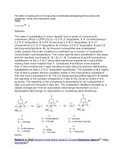The effect of substituents on the reactivity of dichloridotriphenylphosphinoruthenium(II) complexes: kinetic and mechanistic study.

Date
2021-03-24Author
Sitati, Meshack K.
Mutua, Gershom Kyalo
Onunga, Daniel O.
Jaganyi, Deogratius
Mambanda, Allen
Metadata
Show full item recordAbstract
The rates of substitution of chloro ligands from a series of ruthenium(II) complexes, [Ru(κ3-L)(PPh3)Cl2] (L = 2,2′:6′,2′′-terpyridine, 1; 4′-(4-methylphenyl)-2,2′:6′,2′′-terpyridine, 2; 4,4′4″-tri-tert-butyl-2,2′:6′,2′′-terpyridine, 3; 4′-(4-chlorophenyl)-2,2′:6′,2′′-terpyridine, 4; 4-chloro-2,2′:6′,2′′-terpyridine, 5 and 2,6-bis(2-pyrazolyl)pyridine, 6), by thiourea nucleophiles was investigated under pseudo-first-order conditions in methanol as a function of nucleophile concentration and temperature. The chloro ligands were substituted in two steps and the reactivity trend was 4 > 5 > 2 > 1 > 6. Complexes 2 and 3 having donor substituents on the 2,2′:6′,2′′-terpyridine backbone experience a trans-effect making them more reactive than 1. Complexes 4 and 5 are more reactive than 1 due to enhanced π-back-bonding brought about by electron-withdrawing substituents on their 2,2′:6′,2′′-terpyridine backbones. The reactivity of 4 is higher than 5 due to greater electron acceptor-ability of the chlorophenyl substituent than the chloro substituent in 5. The 2,6-bis(pyrazolyl)pyridine ligand in 6 retards the reactivity of the complex compared to 1 due to the cis-donor effect of the pyrazole. The reactivity of the complexes is associative for all nucleophiles in step one and only thiourea in step two. The substitution reactions proceed by a steady changeover from an associative interchange mechanism (Ia) to a dissociative interchange (Id) mechanism on increasing steric hindrance.
URI
https://doi.org/10.1080/00958972.2021.1904234https://www.tandfonline.com/doi/full/10.1080/00958972.2021.1904234
http://r-library.mmust.ac.ke/123456789/1593
Collections
- Gold Collection [989]
